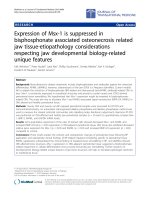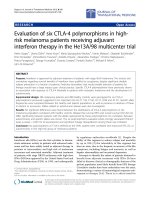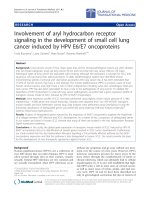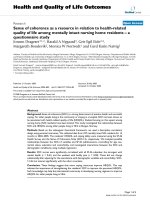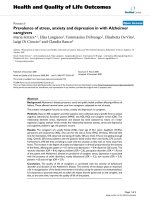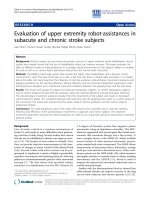Báo cáo hóa học: " Complexity of VTA DA neural activities in response to PFC transection in nicotine treated rats" pdf
Bạn đang xem bản rút gọn của tài liệu. Xem và tải ngay bản đầy đủ của tài liệu tại đây (463 KB, 8 trang )
RESEARC H Open Access
Complexity of VTA DA neural activities in
response to PFC transection in nicotine
treated rats
Ting Y Chen, Die Zhang, Andrei Dragomir, Yasemin M Akay, Metin Akay
*
Abstract
Background: The dopaminergic (DA) neurons in the ventral tegmental area (VTA) are widely implicated in the
addiction and natural reward circuitry of the brain. These neurons project to several areas of the brain, inclu ding
prefrontal cortex (PFC), nucleus accubens (NAc) and amygdala. The functional coupling between PFC and VTA has
been demonstrated, but little is known about how PFC mediates nicotinic modu lation in VTA DA neurons. The
objectives of this study were to investigate the effect of acute nicotine exposure on the VTA DA neuronal firing
and to understand how the disruption of communication from PFC affects the firing patterns of VTA DA neurons.
Methods: Extracellular single-unit recordings were performed on Sprague-Dawley rats and nicotine was
administered after stable recording was established as baseline. In order to test how input from PFC affects the
VTA DA neuronal firing , bilateral transections were made immediate caudal to PFC to mechanically delete the
interaction between VTA and PFC.
Results: The complexity of the recorded neural firing was subsequently assessed using a method based on the
Lempel-Ziv estimator. The results were compared with those obtained when computing the entropy of neural
firing. Exposure to nicotine triggered a significant increase in VTA DA neuro ns firing complexity when
communication between PFC and VTA was present, while transection obliterated the effect of nicotine. Similar
results were obtained when entropy values were estimated.
Conclusions: Our findings suggest that PFC plays a vital role in mediating VTA activity. We speculate that
increased firing complexity with acute nicotine administration in PFC intact subjects is due to the close functional
coupling between PFC and VTA. This hypothesis is supported by the fact that deletion of PFC results in minor
alterations of VTA DA neural firing when nicotine is acutely administered.
Background
The mesocorticolimbic dopamine system, consisting of
the ventral tegmental are a (VTA), prefrontal cortex
(PFC) and nucleus accumbens (NAc), is a critical sub-
strate for the neural adaptations that underlie addiction
[1]. The dopamine (DA) neurons in VTA and their pro-
jection areas, including PFC, NAc, and amygdala, are
thought to be very important in the reward driven beha-
vior induced process by the drugs of addiction [1-5].
Nicotine is a biologically active substance that promotes
tobacco use and has caused the global population health
and economical problems. Unfortunately, nicotine
dependence creates problems for smokers to quit. The
mesocorticolimbic dopamine pathways have been shown
to be stimulated by nicotine. The stimulation originates
from VTA and resulting in DA secretion within the
NAc and PFC is essential for the reinforcing effects of
nicotine [6]. Moreover, other neurotransmitter pathways
like glutamatergic neurons projecting from PFC to VTA
are also involved in the motivational effects of nicotine
[7,8]. The important role played by glutamatergic path-
ways in excitation of mesocorticolimbic dopaminergic
neurons by nicotine has been demonstrated by many
previous studies [9].
The firing activities of VTA DA neurons and addictive
behavior of the animals are believed to be controlled by
* Correspondence:
Department of Biomedical Engineering, Cullen College of Engineering,
University of Houston, Houston, TX 77204, USA
Chen et al. Journal of NeuroEngineering and Rehabilitation 2011, 8:13
/>JNER
JOURNAL OF NEUROENGINEERING
AND REHABILITATION
© 2011 Chen et al; licensee BioMed Central Ltd. This is an Open Access article distributed under the terms of the Creative Commons
Attribution License ( which permits unrestricted use, distribution, and reproduction in
any medium, provided the original work is prop erly cited.
the glutamatergic synaptic inputs from PFC [10-14]. The
PFC is a key structure for executive functions of the
brain [15,16], and has been shown to regulate the firing
pattern of VTA DA neurons. Therefore, the burst firing
in VTA DA neurons increases with PFC stimulation and
the opposite effect is shown with PFC inactivation
[17-21]. The strengthening of input from PFC to VTA
plays an important role in the behavioral sensitization
development, a well-known model for addiction [22-24].
Evidence has shown the functional input loss from PFC
and/or NAc may reduce the effects of these drugs on
the addiction process [13,25-27]. Studies have demon-
strated that under in vivo conditions, the VTA DA neu-
ronsproducesinglespikesand/orburstfiring.
Additionally, they are capable of firing in a slow oscilla-
tory (SO) pattern. The SO generation needs inputs from
other brain area (i.e. PFC) [28,29].
Previous studies show that systemic nicotine injection
can increase the firing ra te and percen tage of bursting
firing of VTA DA neurons [30-33]. However, the PFC
transection only excited 28% of the VTA DA neurons
which could be stimulated only by systemic nicotine
activation, but not by the PFC [32,33]. Also, we have
known that VTA DA neurons’ bursting firing mode
needs excitatory inputs. Therefore, we hypothesize t hat
systemic exposure to nicotine significantly affects the
complexity of firing of the VTA DA neuron and this
alteration should be based on the intact input from
other brain areas. Since PFC is the main source of exci-
tatory inputs to the VTA, the effect of nicotine on the
complexity of VTA DA neuronal firing will be reduced,
when the pathway between PFC and VTA is discon-
nected. To test this hypothesis, we recorded VTA DA
neurons firing and analyzed the data using the advanced
nonlinear dynamical analysis method based on the
Lempel-Ziv (LZ) estimator.
Traditional analysis methods of neuronal firing activity
consist only in measuring spike amplitude and/or
extracting spike frequency informati on in order to char-
acterize the changes produced in the VTA or other
brain areas by diff erent physiological factors or pharma-
cological treatments [34,35]. However, the use of such
methods often renders comparisons within subject
groups not possible. The amplitude characteristics or
frequency of rhythms may differ from subject to subject.
Additionally, they may not offer any insight on the firing
patterns generated by the neural activity. Therefore,
more robust and meaningful analysis methods need to
be used for the dyna mical analysis of neura l recordings.
The dynamical analysis is especially relevant in the con-
text of VTA DA neurons, which are part of neural net-
works that receive inputs from several other brain areas.
Therefore, in this study, we have analyzed the dynamic s
(com plexity) of nicotine-induced neuronal firing patter n
in the VTA DA neurons in both PFC intact and trans-
ected Sprague Dawley (SD) rats using the Lempel-Ziv
(LZ) method. We also estimated the entropy values of
the recorded firing activity and compared the results
obtained from LZ analysis and entropy [36].
Methods
Electrophysiological recordings
All experiment al protocols and surgeries were approved
by The Institutional Animal Care and Use Committee
of Arizona State University. We used male Sprague-
Dawley (SD) rats from Charles River Laboratories (Wil-
mington, MA) weighting between 250 and 300 grams.
All animals were anesthetized with chloral hydrate
(400 mg/kg, intraperitoneal (i.p.) injected ) and mounted
with stereotaxic apparatus (Narishige, Japan) for extra-
cellular single-unit recording. The extracellular record-
ing p ipette was filled with 2 M NaCl (Sigma) and 0.5%
Chicago sky blue (Sigma) solution and placed into the
VTA through a small burr hole in the skull (2.7-3.3 mm
anterior to the lambda and 0.5-0.9 mm lateral to the
midline) by an electro -microdriver. DA neurons, usually
at 6.5-8.5 mm below the cortical surface, were identified
according to the well established electrophysiological
criteria [37-41]. After stable recording was established
for a minimum of five minutes as baseline, (- ) nicotine
hydrogen tartrate salt (Sigma Chemical Co., St. Louis,
MO)atasmoking-relevantconcentration(0.5mg/kg,
i.v. via tai l vein) was administered and recordings were
continued for at least 15 minutes. Mereu et al [42] stu-
died the influence of various doses of nicotine on Dopa-
mine (DA) neurons in rat s either general or local
anesthesia. Their results showed the optimal dose of
nicotine (0.5 mg/kg) that produced a significant increase
in the firing rate of DA neurons. Stolerman et al per-
formed similar studies [43] that confirmed that 0.5 mg/
kg was an optimal and effective dose to study the influ-
ence of nicotine in the neural firings of DA neurons.
Many others [31,44,45] also used 0.5 mg/kg dose of
nicotine to study the behavior of DA neurons. There-
fore, these studies encouraged us to focus on the single,
optimal dose to investigate the influence of nicotine on
the dynamics of neural fir ings of DA neurons. The body
temperature was maintained at 36 to 38° C. The record-
ing sites were marked by ejection of Chicago sky blue
andexaminedusingstandardhistology methods at the
end of experiments [32,33,40].
PFC transection
To stud y the interaction of PFC inputs to the VTA DA
neurons, bilateral transections were made immediate
caudal to the PFC to disrupt the communication
between PFC and VTA DA neuron. A slit was drilled in
the skull 2.0 mm anterior to bregma. Without damaging
Chen et al. Journal of NeuroEngineering and Rehabilitation 2011, 8:13
/>Page 2 of 8
the main artery, a sharp blade was lowered to the base
of skull, t o completely interrupt the connections
between the PFC and the rest of the brain. All surgical
procedures were done under anesthetized condition
[32,33,40].
Data acquisition and analysis
The firing activities of VTA DA neurons were recorded
from five SD rats for both PFC intact and PFC transected
rats. Data was acquired and recorded on the same data
acquisition system (Powerlab, ADInstruments). We quan-
tified the neural dynamics using the LZ complexity esti-
mator as detailed below. Two-minut e segment of data
before the injection of nicotine was analyzed with LZ com-
plexity method. After firing rate of DA neuron has reached
stable condition in response to nicotine, two minutes of
data with the effect of nicotine was analyzed with LZ com-
plexity to understand the dynamics (complexity) of neural
fir ing in response to nicotine exposure to VTA DA neu-
rons with and without input from PFC. All values are
expressed as mean ± SEM. Statistical significance was
assessed using paired two-tailed Student’s t- tests.
Lempel-Ziv Complexity
The firing activity recorded from VTA DA neurons arises
from complex feedback networks and nonlinear intercon-
nections, which are characteristic for such neural sys-
tems. Therefore, we used the LZ estimator as a measure
of complexity (regularity) of the firing activities recor ded
from VTA DA neurons [46-49]. LZ complexity is closely
related to information-theoretical methods such as
entropy [48] and is able to cope with discrete-time sym-
bolic sequences. It quantifies the rate of new pattern gen-
eration along given sequences of symbols. The symbolic
representations of time series are particularly favored
when low-amplitude noise hampers the data [49].
Therefore, we transformed the neural signals into a
finite sequence in the symbolic space. Each sample in the
time domain was assigned a symbol, and the total num-
ber of unique symbols formed the alphabet of the
sequence. Since the data was composed of a series of
action potentials that f orm the response of the neurons
to the input, we used a binary alphabet. The time axis
was divided into discrete bins. The action potentials were
detected using an amplitude threshold, and each time the
threshold was crossed, we placed a “1” in the respective
bin of the symbolic representation of our signals. All bins
with values below the threshold were assigned a “0” [49].
Formally, our signal x(n) w as converted into a binary
sequence S = s(1), s(2), , s( n), where
si
if x i T
otherwise
()
,()
,,
=
<
⎧
⎨
⎩
0
1
(1)
where T is the threshold and can be chosen as 2SD(x
(n)), where SD(x(n)) represents the standard deviation of
the original signal x(n) [49].
For computing the LZ complexity, the sequence S is
parsed from left to right, and a complexity cou nter c(n)
is increased each time a new subsequence (distinct
word) is encountered. The algorithm followed is:
• Let S(i, j) denote a substring of S that starts at
position i and ends at position j, where i<j. S(i, j)=
s
i
s
i+1
s
j
and when i>j, S(i, j) = {}. The vocabulary
of the sequence S, V(S), is the set of all unique sub-
strings (words) S(i, j)ofS.
• The parsing procedure starts by comparing a sub-
string S(i, j) to the vocabulary that is comprised of
all substrings of S up to j-1, that is V(S(1, j - 1)). If
S(i, j)ispresentinV(S(1, j - 1)) then update S(i, j)
and V(S(1, j - 1)) to S(i, j + 1) V(S(1, j)), respectively,
and repeat the previous check. If the substring is not
present, place a dot after S(j) to indicate the end of a
new component, update S(i, j)andV(S(1, j - 1)) to S
(j+1,j+1) and V(S(1, j)), respectively, and the pro-
cess continues. The whole parsing operation begins
at S(1,1)
and continues until j=n, the total length
of the binary sequence [47].
For example, the sequence S = 1011110100010 is
parsedas1.0.11.110.100.010.Therefore,thevoca-
bulary of S is six. Similarly, a sequence S =
0001101001000 101 would be parsed as 0 . 001 . 10 . 100 .
1000 . 101, and hence yields a vocabulary sized six [46].
LZ complexity is defined as the total number of words
in the decomposition, c(n). The normalized LZ complex-
ity is defined as
C
cn
nn
LZ
=
()
/log
.
2
(2)
More details on the LZ method and its implementa-
tion are given elsewhere [46-50].
Entropy
In addition to the LZ estimator, we also analyzed the
same data set using the approximated entropy (com-
plexity ) since it has been widely used for the analysis of
biomedical signals. The entropy estimates can be com-
puted as follows [36]:
Hpnpn
n
=− ⋅
∑
()log ()
2
(3)
Where p(n) is t he probability of observing n spikes in
thetimewindow.Thetimeresolutionwas10msand
entropy was computed on segments of 20 s length.
Chen et al. Journal of NeuroEngineering and Rehabilitation 2011, 8:13
/>Page 3 of 8
Results
To evaluat e the firing pattern changes of VTA DA neu-
rons to systemic nicotine exposure, the extracellular sin-
gle-unit recordings were performed in DA neurons in
anesthetized rats as described in methods section. Two
minutes of data was divided in 20-second windows for
analysis purposes. LZ complexity was estimated for each
20-second window and the values were a veraged. The
same procedure was applied for segments before and
after nicotine exposure. The data analyzed for nicotine
effect was taken after firing rate of DA neuron has
reached stable condition in response to nicotine
administration.
Figure 1 shows an example of 20-second segment
action potential recorded from PFC intact VTA DA
neuron before and after nicotine injection. Figure 2
shows an example of 20-second segment action poten-
tial recorded from PFC transected VTA DA neuron
before and after nicotine inje ction. Both firing rate and
firing pattern look similar when observed with naked
eye. The left panel of Figure 3 shows the averaged LZ
complexity values from five PFC intact SD rats before
and after nicotine administration. The right panel of
Figure 3 shows the averaged LZ co mplexity values from
five PFC transected SD rats before and after nicotine
administration.
The LZ complexity values were 0.2079 ± 0.0075 before
nicotine administration and were 0.2454 ± 0.0067 after
nicotine administration for SD rats with PFC intact. As
shown in Figure 3, there is significant increase in the
complexity values in DA neurons after nicotine expo-
sure (p < 0.01) for PFC intact rats. Figure 3 indicates
that nicotine plays an important role in affecting the fir-
ing of DA neurons i n VTA. Considering that the excita-
tory input to VTA DA neurons is mainly originated
from the P FC, the above results suggests a possibility
that systemic nicotine-induced changes of VTA neuron
firing might be mediated through an alteration in PFC
neural function. To t est this hypothesis, we interrupted
the PFC and VTA interaction by acute PFC transection.
The transection was done mechanically immediate cau-
dal to the PFC by acute transecting both sides of PFC as
described in methods. The LZ complexity values were
0.2273 ± 0.0099 before nicotine administration and were
0.2248 ± 0.0101 after nicotine administration for SD
rats with PFC transected. As shown in Figure 3, there is
no significant difference (p = 0.8085).
In addition to LZ complexity analysis method, we also
calculated entropy estimates of the same neural recordings
for comparison purposes. The entropy values were 0.2179
± 0.0078 before nicotine administration and were 0.2766 ±
0.0100 after nicotine administration for SD rats with PFC
0 0.2 0.4 0.6 0.8 1 1.2 1.4 1.6 1.8
2
x 10
5
−40
−20
0
20
40
Time (ms)
Amplitude (mV)
PFC Intact Before Nicotine Injection
0 0.2 0.4 0.6 0.8 1 1.2 1.4 1.6 1.8
2
x 1
0
5
−40
−20
0
20
40
Time (ms)
Amplitude (mV)
PFC Intact After Nicotine Injection
Figure 1 Example action potential recorded from PFC intact VTA DA neuron of SD rat before and after nicotine injection.
Chen et al. Journal of NeuroEngineering and Rehabilitation 2011, 8:13
/>Page 4 of 8
0 0.2 0.4 0.6 0.8 1 1.2 1.4 1.6 1.8
2
x 10
5
−40
−20
0
20
40
Time (ms)
Amplitude (mV)
PFC Transected Before N
i
cot
i
ne Inject
i
on
0 0.2 0.4 0.6 0.8 1 1.2 1.4 1.6 1.8
2
x 1
0
5
−40
−20
0
20
40
Time (ms)
Amplitude (mV)
PFC Transected After Nicotine Injection
Figure 2 Example action potential recorded from PFC transected VTA DA neuron of SD rat before and after nicotine injection.
PF
C
Inta
c
t PF
C
Tran
sec
t
ed
0.15
0.2
0.25
0.3
0.35
0.4
LZ Complex
i
ty
SD Rat LZ Complexity
Before Nicotine Injection
After Nicotine Injection
**
Figure 3 The mean LZ complexity values ± SEM of five intact SD rats and five transected SD rats before and after nicotine exposure (**
indicates p < 0.01, paired two-tailed Student’s t-test).
Chen et al. Journal of NeuroEngineering and Rehabilitation 2011, 8:13
/>Page 5 of 8
intact. As shown in Figure 4, there is a significant increase
in the entropy values in DA neurons after nicotine expo-
sure (p < 0.01) for PFC intact rats. The entropy values
were 0.2382 ± 0.0107 before nicotine administration and
were 0.2396 ± 0.0118 after nicotine administration for SD
rats with PFC transected. As shown in Figure 4, there is
no significant difference (p = 0 .9319).
Discussion and conclusion
In this study, we used nonlinear dynamical analysis meth-
ods based on the LZ method and the approximated entropy
to analyze VTA DA neuronal firing activity induced b y sys-
temic administration of nicotine on PFC intact and trans-
ected rats. The analyses allo w us to quantitatively
distinguish the firing patterns dynamics of VTA DA action
potentials. These patterns may reflect different status of
neuronal network synchronization. Nonlinear d ynamical
analysis of neural patterns demonstrated that nicotine only
significantly affects PFC intact rats and this may be due to
the close connection between PFC and VTA.
The neural activity recorded from VTA DA neurons
arises from complex networks and non-linear intercon-
nections, which are neural systems characteristics. The
fact that the neural activity arises from such c omplex
systems, as well as the symbolic-like features of the
recorded data, make the use of the LZ complexity mea-
sure suitable in the context of the present work [51-68].
Provided by its robustness over other complexity/
entropy measures, the LZ complexity has been applied
extensively in biomedical signal analysis as a metric to
estimate the complexity of discrete-time physiologic sig-
nal. For example, LZ has been used for recognition of
structural regularities [54], for complexity characteriza-
tion of DNA sequences [57-59], to develop new meth-
ods for discovering patterns in DNA sequences by
applying it to genomic sequences of Plasmodium falci-
parum [59], and to estimate the entropy of neural dis-
charges (spike trains) [48,60]. LZ complexity has also
been used to study brain function [62], brain informa-
tion transmission [63], EEG complexity in patients with
Alzheimer’s disease [64], epileptic s eizures [65], ECG
dyna mics [66], and to evaluate the nature and dynamics
of hippocampal neuronal oscillations [50,69,70].
In recent studies the performance of the LZ estimator
was compared to other entropy measures for the analy-
sis of the biomedical sign als [49,71]. Although LZ com-
plexity was shown to be related to entropy [48,68], it
prov ed to be less sensitive to the length of data [71]. Its
better performance in terms of sensitivity to signal
bandwidth changes was also reported, when compared
to Shannon entropy [71].
All these previous studies encouraged u s to use this
nonlinear dynamical analysis method, based on the LZ
complexity method, to gain insights into the VTA DA
neuronal activity induced by systemic administration of
nicotine to both PFC intact and transected subjects. The
results obtained when using the LZ estimator were con-
firmed by those o btained when the entropy of the neu-
ronal firing was estimated. Therefore, our results
confirm our hypothesis that nicotine significantly affects
PF
C
Inta
c
t PF
C
Tran
sec
t
ed
0.15
0.2
0.25
0.3
0.35
0.4
E
ntropy
S
D Rat Entropy
Before Nicotine Injection
After Nicotine Injection
**
Figure 4 The mean entropy values ± SEM of five intact SD rats and five transected SD rats before and a fter nicotine exposure (**
indicates p < 0.01, paired two-tailed Student’s t-test).
Chen et al. Journal of NeuroEngineering and Rehabilitation 2011, 8:13
/>Page 6 of 8
the firing of VTA DA neurons and that this effect is
based on the intact input from PFC.
The increase of the excitat ory drive onto the DA neu-
rons is activated by presynaptic terminals of glutamater-
gic afferents induced by nicotine [31,72,73]. This
potentiated glutamatergic drive causes DA neurons to
fire more in a burst or phasic mode [30,31], since the
firing rate and pattern of VTA DA neurons change with
nicotine exposure. We speculate the increased complex-
ity in PFC intact subject is due to a close functional
coupling between PFC and VTA and the increased
neural activity in VTA DA neurons. Our analysis
demonstrated that the complexity/entropy values of
neural activity after nicotine exposure were significantly
increased when the connection between PFC and VTA
is intact. On the other hand, the complexity/entropy
values have no significant change when the input from
PFC to VTA is disconne cted. The reason for the
increased complexity and entropy is the increased neural
activity resulted from nicotine exposure.
The PFC and VTA have close functional coupling. Sti-
mulation of PFC increases burst firing in VTA DA neu-
rons, while deletion of PFC induces the opposite effect
[17-19,21,74]. Gao et al [40] reported that under non-sti-
mulation conditions, the activity of VTA DA neurons co-
varied with PFC neuronal activity, suggesting a close func-
tional coupli ng between PFC and VTA [40]. Evidence indi-
cates a key control of VTA neuronal function by PFC [38].
Our analysis indicates that the LZ estimators and
entropy are useful tools for the characterization of the
dynamical changes in VTA DA neuronal activity. As
demonstrated in our analysis, such changes could be
quantitatively represented as an impairment of neuronal
firing during nicotine exposure and PFC transection.
Acknowledgements
We would like to thank Ms. Jessica Diefenderfer for her editing the
manuscript.
Authors’ contributions
TC performed experiments and the data analysis and helped to write the
manuscript, DZ helped with the experiments and helped to write the
manuscript, AD contributed to the data analysis and helped to write the
manuscript, YMA helped with the experiments and helped to write the
paper. MA oversaw the data collection, the data analysis, and helped to
write the manuscript. All authors read and approved the final manuscript.
Competing interests
The authors declare that they have no competing interests.
Received: 13 July 2010 Accepted: 27 February 2011
Published: 27 February 2011
References
1. Kauer JA, Malenka RC: Synaptic plasticity and addiction. Nature Reviews
Neuroscience 2007, 8:844-858.
2. Kalivas PW: Interactions between dopamine and excitatory amino acids
in behavioral sensitization to psychostimulants. Drug and Alcohol
Dependence 1995, 37:95-100.
3. Tong ZY, Overton PG, Martinez-Cue C, Clark D: Do non-dopaminergic
neurons in the ventral tegmental area play a role in the responses
elicited in A10 dopaminergic neurons by electrical stimulation of the
prefrontal cortex? Exp Brain Res 1998, 118:466-476.
4. Wolf ME: The role of excitatory amino acids in behavioral sensitization to
psychomotor stimulants. Prog Neurobiol 1998, 54:679-720.
5. Berke JD, Hyman SE: Addiction, dopamine, and the molecular
mechanisms of memory. Neuron 2000, 25:515-532.
6. Corrigall WA, Franklin KB, Cohen KM, Clarke PB: The mesolimbic
dopaminergic system is implicated in the reinforcing effects of nicotine.
Psychopharmacology (Berl) 1992, 107:285-289.
7. Picciotto MR, Corrigall WA: Neuronal systems underlying behaviors
related to nicotine addiction: neural circuits and molecular genetics. J
Neurosci 2002, 22:3338-3341.
8. Watkins SS, Koob GF, Markou A: Neural mechanisms underlying nicotine
addiction: acute positive reinforcement and withdrawal. Nicotine Tob Res
2000, 2:19-37.
9. Wang F, Chen H, Steketee JD, Sharp BM: Upregulation of ionotropic
glutamate receptor subunits within specific mesocorticolimbic regions
during chronic nicotine self-administration. Neuropsychopharmacology
2007, 32:103-109.
10. Kalivas PW: Neurotransmitter regulation of dopamine neurons in the
ventral tegmental area. Brain Res Rev 1993, 18:75-113.
11. White FJ: Synaptic regulation of mesocorticolimbic dopamine neurons.
Annu Rev Neurosci 1996, 19:405-436.
12. Overton PG, Clark D: Burst firing in midbrain dopaminergic neurons. Brain
Res Rev 1997, 25:312-334.
13. Dong Y, Nasif FJ, Tsui JJ, Ju WY, Cooper DC, Hu XT, Malenka RC, White FJ:
Cocaine-induced plasticity of intrinsic membrane properties in prefrontal
cortex pyramidal neurons: adaptations in potassium currents. J Neurosci
2005, 25:936-940.
14. Gao C, Wolf M: Dopamine alters AMPA receptor synaptic expression and
subunit composition in dopamine neurons of the ventral tegmental
area cultured with prefrontal cortex neurons. J Neurosci 2007,
27:14275-14285.
15. Miller EK, Cohen JD: An integrative theory of prefrontal cortex function.
Annu Reve Neurosci 2001,
24:167-202.
16.
Miller EK, Freedman DJ, Wallis JD: The prefrontal cortex: categories,
concepts and cognition. Philos Trans R Soc Lond B Biol Sci 2002,
357:1123-1136.
17. Gariano RF, Groves PB: Burst firing induced in midbrain dopamine
neurons by stimulation of the medial prefrontal and anterior cingulated
cortices. Brain Res 1988, 462:194-198.
18. Svensson TH, Tung CS: Local cooling of pre-frontal cortex induces
pacemaker-like firing of dopamine neurons in rat ventral tegmental area
in vivo. Acta Physiol Scand 1989, 136:135-136.
19. Murase S, Grenhoff J, Chouvet G, Gonon FG, Svensson TH: Prefrontal cortex
regulates burst firing and transmitter release in rat mesolimbic
dopamine neurons studied in vivo. Neurosci Lett 1993, 157:53-56.
20. Overton PG, Tong ZY, Clark D: A pharmacological analysis of the burst
events induced in midbrain dopaminergic neurons by electrical
stimulation of the prefrontal cortex in the rat. J Neural Transm 1996,
103:523-540.
21. Tong ZY, Overton PG, Clark D: Stimulation of the prefrontal cortex in the
rat induces patterns of activity in midbrain dopaminergic neurons which
resemble natural burst events. Synapse 1996, 22:195-208.
22. Saal D, Dong Y, Bonci A, Malenka RC: Drugs of abuse and stress trigger a
common synaptic adaptation in dopamine neurons. Neuron 2003,
37:577-582.
23. Robinson TE, Berridge KC: The psychology and neurobiology of addiction:
an incentive-sensitization view. Addiction 2000, 95(Suppl 2):S91-117.
24. Everitt BJ, Wolf ME: Psychomotor stimulant addiction: a neural systems
perspective. J Neurosci 2002, 22:3312-3320.
25. Li Y, Vartanian AJ, White FJ, Xue XJ, Wolf ME: Effects of the AMPA receptor
antagonist NBQX on the development and expression of behavioral
sensitization to cocaine and amphetamine. Psychopharmacology (Berl)
1997, 134:266-276.
26. Li Y, Hu XT, Berney TG, Vartanian AJ, Stine CD, Wolf ME, White FJ: Both
glutamate receptor antagonists and prefrontal cortex lesions prevent
induction of cocaine sensitization and associated neuroadaptations.
Synapse 1999, 34:169-180.
Chen et al. Journal of NeuroEngineering and Rehabilitation 2011, 8:13
/>Page 7 of 8
27. Tzschentke TM: Pharmacology and behavioral pharmacology of the
mesocortical dopamine system. Prog Neurobiol 2001, 63:241-320.
28. Shi WX, Pun CL, Zhou Y: Psychostimulants induce low-frequency
oscillations in the firing activity of dopamine neurons.
Neuropsychopharmacology 2004, 29:2160-2167.
29. Shi WX: Slow oscillatory firing: a major firing pattern of dopamine
neurons in the ventral tegmental area. J Neurophysiol 2005, 94:3516-3522.
30. Grenhoff J, Aston-Jones G, Svensson TH: Nicotinic effects on the firing
pattern of midbrain dopamine neurons. Acta Physiol Scand 1986,
128:351-358.
31. Schilstrom B, Rawal N, Mameli-Engvall M, Nomikos GG, Svensson TH: Dual
effects of nicotine on dopamine neurons mediated by different nicotinic
receptor subtypes. Int J Neuropsychopharmacol 2003, 6:1-11.
32. Wu J, Zhang D, Lukas RJ: Impact of prefrontal cortex (PFC) in systemic
nicotine-induced midbrain dopamine neuron excitation [abstract].
Program No. 34.5. 2009 Neuroscience Meeting Planner Chicago, IL: Society for
Neuroscience; 2009.
33. Zhang D, Gao M, Xu D, Shi WX, Gutkin B, Lukas R, Wu J: Nicotine perturbs
functional coupling between the prefrontal cortex and the ventral
tegmental area in vivo: A new mechanism of nicotine reward., submitted
for publication.
34. Friedman A, Friedman Y, Dremencov E, Yadid G: VTA dopamine neuron
bursting is altered in an animal model of depression and corrected by
desipramine. J Mol Neurosci 2008, 34:201-209.
35. Steffensen SC, Taylor SR, Horton ML, Barber EN, Lyle LT, Stobbs SH,
Allison DW: Cocaine disinhibits dopamine neurons in the ventral
tegmental area via use-dependent blockade of GABA neuron voltage-
sensitive sodium channels. Eur J Neurosci 2008, 28:2028-2040.
36. Rieke F, Warland D, Van Steveninck R, Bialek W: Spikes: Exploring the Neural
Code Cambridge: MIT Press; 1999.
37. Bunney BS, Walters JR, Roth RH, Aghajanian GK: Dopaminergic neurons:
effect of antipsychotic drugs and amphetamine on single cell activity. J
Pharmacol Exp Ther 1973, 185:560-571.
38. Grace AA, Bunney BS: Intracellular and extracellular electrophysiology of
nigral dopaminergic neurons - 1. Identification and characterization.
Neuroscience 1983, 10:301-315.
39. Ungless MA, Magill PJ, Bolam JP: Uniform inhibition of dopamine neurons in
the ventral tegmental area by aversive stimuli. Science 2004, 303:2040-2042.
40. Gao M, Liu CL, Yang S, Jin GZ, Bunney BS, Shi WX: Functional coupling
between the prefrontal cortex and dopamine neurons in the ventral
tegmental area. J Neurosci 2007, 27:5414-5421.
41. Gao M, Jin Y, Yang K, Zhang D, Lukas RJ, Wu J: Mechanisms involved in
systemic nicotine-induced glutamatergic synaptic plasticity on dopamine
neurons in the ventral tegmental area. J Neurosci 2010, 30:13814-13825.
42. Mereu G, Yoona KW, Boi V, Gessaa GL, Naesa L, Westfall TC:
Preferential
stimulation of ventral tegmental area dopaminergic neurons by
nicotine. European Journal of Pharmacology 1987, 141:395-399.
43. Stolerman IP, Bunker P, Jarvik ME: Nicotine Tolerance in Rats: Role of Dose
and Dose Interval. Psychopharmacologia (Berl) 1974, 34:317-324.
44. Grenhoff J, Aston-Jones G, Svensson TH: Nicotinic effects on the firing
pattern of midbrain dopamine neurons. Acta Physiologica Scandinavica
2008, 128:351-358.
45. Schilström B, Fagerquist MV, Zhang X, Hertel P, Panagis G, Nomikos GG,
Svensson TH: Putative role of presynaptic α7* nicotinic receptors in
nicotine stimulated increases of extracellular levels of glutamate and
aspartate in the ventral tegmental area. Synapse 2000, 38:375-383.
46. Lempel A, Ziv J: On the complexity of finite sequences. IEEE Trans Inform
Theory 1976, 22(1):75-88.
47. Hu J, Gao J, Principe J: Analysis of biomedical signals by the Lempel-Ziv
complexity: the effect on finite data size. IEEE Trans Biomed Eng 2006,
53(12):2606-2609.
48. Amigo JM, Szczepanski J, Wajnryb E, Sanchez-Vives MV: Estimating the
entropy rate of spike trains via Lempel-Ziv complexity. Neural Computat
2004, 16(4):717-736.
49. Aboy M, Hornero R, Abasolo D, Alvarez D: Interpretation of the Lempel-Ziv
complexity measure in the context of biomedical signal analysis. IEEE
Trans Biomed Eng 2000, 53(11):2282-2288.
50. Akay YM, Dragomir A, Song C, Wu J, Akay M: Hippocampal gamma
oscillations in rats. IEEE Eng Med Biol Mag 2009, 28(6):92-95.
51. Kurths J, Schwarz U, Witt A, Krampe RT, Abel M: Measures of complexity in
signal analysis, chaotic, fractal and nonlinear signal processing. AIP 1995,
375:33-54.
52. Kaspar F, Schuster HG: Easily calculable measure for the complexity of
spatiotemporal patterns. Phys Rev 1987, 36A:842-848.
53. Tang XZ, Tracy ER, Boozer AD, DeBrauw A, Brown R: Symbol sequence
statistics in noisy chaotic signal reconstruction. Chaos 1995, 51:3871-3889.
54. Radhakrishnan N, Wilson JD, Loizou P: An alternate partitioning technique
to quantify the regularity of complex time series. Int J Bifurcation Chaos
2000, 10:1773-1779.
55. Zhang X, Zhu Y, ThaKor NV, Wang Z: Detecting ventricular tachycardia
and fibrillation by complexity measure. IEEE Trans Biomed Eng 1984, BME-
31
:770-778.
56. Zhang X, Roy RJ: Detecting movement during anesthesia by EEG
complexity analysis. Med Biol Eng Comput 1999, 37:327-334.
57. OrlovYL,PotapovVN:Complexity:Aninternetresourceforanalysis
of DNA sequence complexity. Nucleic Acids Res 2004, 32:
W628-W633.
58. Gusev VD, Nemytikova LA, Chuzhanova NA: On the complexity measures
of genetic sequences. Bioinformatics 1999, 15:994-999.
59. Stern L, Allison L, Coppel RL, Dix TI: Discovering patterns in plasmodium
falciparum genomic DNA. Mol Biochem Parasitol 2001, 118:175-186.
60. Szczepaski J, Amigo JM, Wajnryb E, Sanchez-Vives MV: Application of
Lempel-Ziv complexity to the analysis of neural discharges. Network
2003, 14:335-350.
61. Otu HH, Sayood K: A new sequence distance measure for phylogenetic
tree construction. Bioinformatics 2003, 19:2122-2130.
62. Wu X, Xu J: Complexity and brain function. Acta Biophys Sin 1991,
7:103-106.
63. Xu J, Liu Z, Liu R, Yang QF: Information transformation in human cerebral
cortex. Physica D 1997, 106:363-374.
64. Abasolo D, Hornero R, Gomez C, Garcia M, Lopez M: Analysis of EEG
background activity in Alzheimer’s disease patients with Lempel-Ziv
complexity and central tendency measure. Med Eng Phys 2006,
28:315-322.
65. Radhakrishnan N, Gangadhar B: Estimating regularity in epileptic seizure
time-series data. IEEE Eng Med Biol Mag 1998, 17:89-94.
66. Zhang XS, Zhu YS, Zhang XJ: New approach to studies on ECG dynamics:
extraction and analysis of QRS complex irregularity time series. Med Biol
Eng Comput 1997, 35:467-473.
67. Aboy M, Hornero R, Abasolo D, Alvarez D: Interpretation of the Lempel-Ziv
complexity measure in the context of biomedical signals. IEEE Trans
Biomed Eng 2006, 53:2282-2288.
68. Szczepaski J, Amigo JM, Wajnryb E, Sanchez-Vives MV: Characterizing spike
trains with Lempel-ziv complexity. Neurocomputing 2004, 58-60:79-84.
69. Akay M, Wang K, Akay YM, Dragomir A, Wu J: Nonlinear dynamical
analysis of carbachol induced hippocampal oscillations in mice. Acta
Pharm Sin 2009, 30:859-867.
70. Dragomir A, Akay YM, Akay M: Modeling carbachol-induced hippocampal
network synchronization using hidden markov models. J Neural Eng
2010, 7:056012.
71. Ferenets R, Lipping T, Anier A, Jantti V, Melto S, Hovilehto S: Comparison of
entropy and complexity measures for the assessment of depth of
sedation. IEEE Trans Biomed Eng 2006, 53:1067-1077.
72. Pidoplichko VI, Noguchi J, Areola OO, Liang Y, Peterson J, Zhang T, Dani JA:
Nicotinic cholinergic synaptic mechanisms in the ventral tegmental area
contribute to nicotine addiction. Learn Mem 2004, 11:60-69.
73. Mansvelder HD, McGehee DS: Long-term potentiation of excitatory inputs
to brain reward areas by nicotine. Neuron 2000, 27:349-357.
74. Overton PG, Tong ZY, Brain PF, Clark D: Preferential occupation of
mineralocorticoid receptors by corticosterone enhances glutamate-
induced burst firing in rat midbrain dopaminergic neurons. Brain Res
1996, 737:146-154.
doi:10.1186/1743-0003-8-13
Cite this article as: Chen et al.: Complexity of VTA DA neural activities
in response to PFC transection in nicotine treated rats. Journal of
NeuroEngineering and Rehabilitation 2011 8:13.
Chen et al. Journal of NeuroEngineering and Rehabilitation 2011, 8:13
/>Page 8 of 8

